So I think myself fortunate that my job gives me the opportunity to travel, even if it is to a neighbouring Cretan town. I can't examine English students in my own town for obvious reasons, so when I'm called up to interview and assess students of English sitting internationally recognised examinations, I'm sent to Iraklio, the capital of Crete, located in the northern mid-point of the island (~140km from Hania), or Rethimno, another town in Western Crete, situated mid-way between Hania and Iraklio (~60km from Hania).
Just before Christmas, I was sent to Rethimno. To get there from Hania (if you don't want to use the motorway), just keep the coast to your left as you drive. Even the motorway offers one of the most scenic routes in Western Crete. There are many picturesque villages tucked away behind the mountains along this route, while the longest stretch of beach guides your path.
The flora borders the Hania-Rethimno motorway, which skirts along the northern coastline of Western Crete.
In less than an hour of driving, Rethimno comes into view. This isn't a long distance in modern terms, but less than 50 years ago, the road system in Crete was still undeveloped. In the average Haniot's mind, leaving his own province would have felt like crossing the ocean, as he rode his donkey along the bendy coastline; it was this reason that the main centres of Crete (from west to east: Hania, Rethimno, Iraklio, Mires, Ayios Nikolas, Sitia, Ierapetra) all developed semi-autonomously, no one depending on the other for services and facilities. To a certain extent, this continues. There is a friendly animosity between competing towns in Crete (mainly Hania and Iraklio) for the opportunity to keep certain pan-Cretan services within their own jurisdiction. For example, the Court of Appeal in Crete used to be located in Hania (the former capital of Crete), but is now located in Iraklio (the capital of Crete since 1971), which is the most populated town in the island, with 150,000 residents (compared to Hania'a 60,000).
On first sight, Rethimno town looks just like Hania. In fact, Rethimno is the bonsai version of Hania. It's located on the coast,
spread out amongst the remains of a walled town,


Left: an old gate built in the old walled city in Hania; right: an old gate built in the old walled city in Rethimno.
bordered by a Venetian fortress,
with a centrally located municipal park,
a couple of minarets,
This fact makes it all the more amazing to discover that Rethimno cuisine is actually different in certain respects to the Haniotiko cuisine. We're talking about similar towns in similar locations on the same Mediterranean island, who don't always understand each other's culinary terms. Despite their relative proximity, the towns of Crete all maintain their own unique traditions and customs, and this includes special dishes and cooking techniques.

Left: singlino from Hania (specifically the region of Sfakia); right: apaki from Rethimno (speificially the region of Anoyia) - both of these are preserved smoked pork. They are made slightly differently using different herbs in each case, but in essence, they are the same thing: the traditional way to preserve pork indefinitely, pre-refrigeration .
Over the years, the distance between Hania and and other main centres in Crete has decreased with modern road and communications improvements, but if a Hanioti and a Cretan from another part of the island met up with each other 50 years ago, their conversations concerning food would have sounded like Chinese whispers.
Rethimnioti talking to a Hanioti:
Boureki? What's that?
Mizithra? Shouldn't it be sweeter?
Kalitsounia with spinach? Beg your pardon?
Hanioti talking to an Iraklioti:
Tzoulamas? Is that flora or fauna?
Spaghetti at a wedding? Don't you make pilafi?
Kalitsounia with sugar? And yeast in the pastry?
Now that Cretans are more mobile, and with intermarriages between different regions of the island, most people in Crete can enjoy regional cuisine from other parts of the island without even realising that these dishes are not often made locally. One of my favorite Cretan non-Haniotiko foods is sweet kalitsounia, a specialty from Eastern Crete, which is why these kalitsounia are often referred to as 'kalitsounia kastrina'; 'kastro' (κάστρο) means 'castle', and in Crete, the biggest Venetian fortress (castle) is found in Iraklio. These kalitsounia use a sweeter kind of mizithra cheese than what is made in Hania, and the pastry used to make them contains yeast. But they are also widely available in sweet shops (zaharoplasteia) and bakeries in Hania.
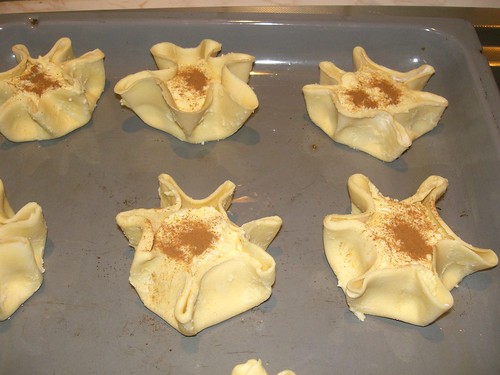
When I bought my regular fortnightly supply of freshly made filo pastry, the store owner treated me to a little gift of puffy flaky pastry, ready cut in rounds. It's not a pastry I buy (at all), but it reminded me of the sweet kalitsounia I bring back for my children when I'm working in Iraklio or Rethimno, where they are more commonly sold. These kalitsounia are in the shape of what is known as 'lichnaraki' (little lamp), because they look like the lamps once used in village houses before Cretan homes were electrified.
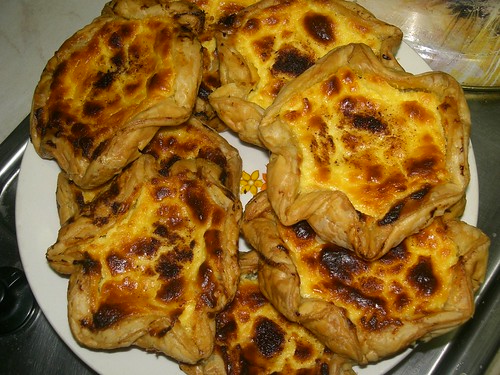
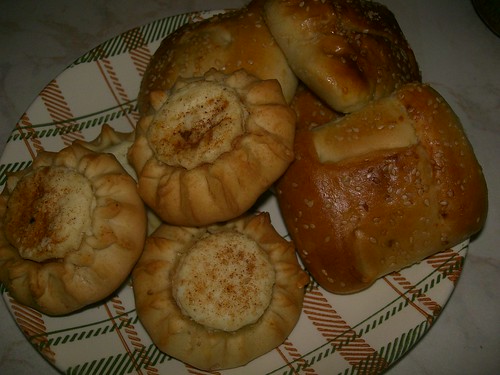
My lichnarakia didn't hold their shape as well as the store-bought ones, due to the pastry I used. The square pastries - called 'anevata' - are made with the same ingredients as the lichnarakia, and are also an Eastern Crete specialty.
Although the pastry used to make sweet kalitsounia is different from the buttery pastry that I used to make these lichnarakia, the filling is pretty much standard: mizithra (a kind of ricotta cheese), egg and sugar are mixed to a paste, which is used to fill the pastry shells, with cinammon sprinkled on top. The result is a warming aromatic kind of cheese pie with a tempting sweet taste. And they are so easy to make if you use ready-made pastry.
©All Rights Reserved/Organically cooked. No part of this blog may be reproduced and/or copied by any means without prior consent from Maria Verivaki.

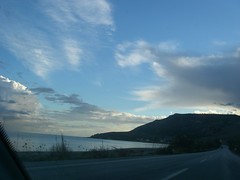


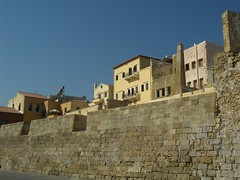
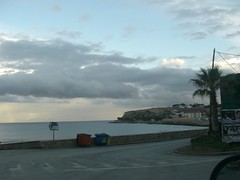


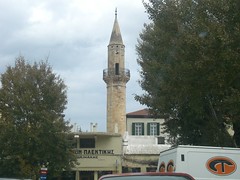
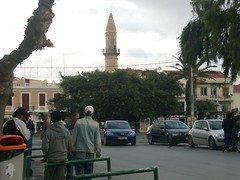

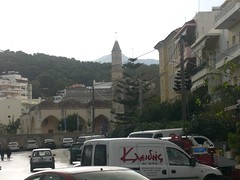
Oh my gosh! I swear that sometimes you can read my mind. The pictures in your wild greens post made me wonder how folks got around Greece years ago. That made me wonder how the different areas within Crete developed culturally including language, customs, and food. Now I log in today and here's a terrific side by side post about two areas on Crete! I've learned more about Greece from your website than any book I've read. I just love learning about your home. Another great post from Maria!
ReplyDeleteI agree with Paula...you cover life in Crete really well. We get great insights into everyday life. My parents are from Peloponniso (sparti to be exact) and I know the regional culinary terms can vary a fair bit. It's obviously the same in Crete. Great reading again Maria!
ReplyDeleteI always learn so much from your posts. The ride looks beautiful. Your lichnarakia look lovely.
ReplyDeleteI think I really missed out by not trying a lot of the pastries and sweets in Greece.
ReplyDeleteΜαρία εξελίχθηκες σε μεγάλο δημοσιογράφο!!
ReplyDeleteOur koumbaroi moved to Rethymno about 5 years ago. They come to NY every Christmas and just left for Crete a mere 10 days ago. We have yet to visit them there as each summer we are in Greece we must visit my in-laws in Athens, Agrinio and Kerkyra (and ocassionally squeeze in a small trip to Kalymnos, which my own family is from). We're looking forward to getting there one day.
ReplyDeleteNevertheless, my koumbara brought with her a box of lichnarakia and they were delicious.
I've finally found you again! I couldn't remember what your blog was called...
ReplyDeleteNot sure if I came across kalitsounia when I was in Hania (many, many years ago!), but I certainly wish I could have some now! They look and sound delicious!
Mmmmm... These lichnarakia look awesome! What a pity I can't find mizithra here. I wonder, does its taste differ very much from the ricotta's?
ReplyDeleteOne of the amazing things about Greece, so small yet so diverse in geography, customs, food tastes and even dialects.
ReplyDeleteThe lichnarakia look fine...rustic and surely delish.
Rethimno looks like a pleasant little place.Love the cheesy lichnarakias.
ReplyDeleteHope you don't mind I linked back Your Olive harvest post in my post about Olive oil.
That is a beautiful drive! I don't suppose I will ever be able to go so far to see it for myself, so I'll be happy just looking through your eyes.
ReplyDeleteThose pastries look wonderful. Now you've made me hungry. :-) Wish I had some of those.
Beautiful pastries. And so nice you get paid to leave town once in awhile!
ReplyDelete